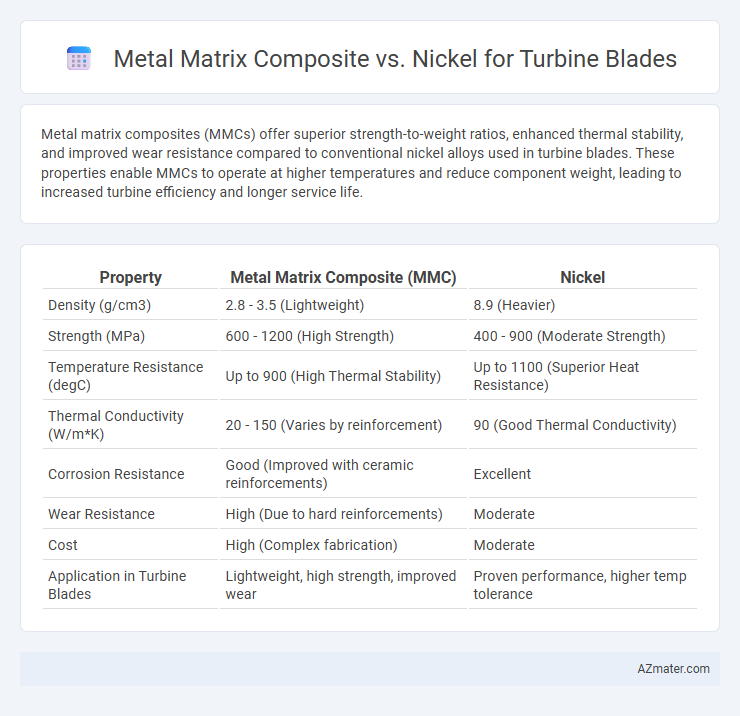Metal matrix composites (MMCs) offer superior strength-to-weight ratios, enhanced thermal stability, and improved wear resistance compared to conventional nickel alloys used in turbine blades. These properties enable MMCs to operate at higher temperatures and reduce component weight, leading to increased turbine efficiency and longer service life.
Table of Comparison
| Property | Metal Matrix Composite (MMC) | Nickel |
|---|---|---|
| Density (g/cm3) | 2.8 - 3.5 (Lightweight) | 8.9 (Heavier) |
| Strength (MPa) | 600 - 1200 (High Strength) | 400 - 900 (Moderate Strength) |
| Temperature Resistance (degC) | Up to 900 (High Thermal Stability) | Up to 1100 (Superior Heat Resistance) |
| Thermal Conductivity (W/m*K) | 20 - 150 (Varies by reinforcement) | 90 (Good Thermal Conductivity) |
| Corrosion Resistance | Good (Improved with ceramic reinforcements) | Excellent |
| Wear Resistance | High (Due to hard reinforcements) | Moderate |
| Cost | High (Complex fabrication) | Moderate |
| Application in Turbine Blades | Lightweight, high strength, improved wear | Proven performance, higher temp tolerance |
Introduction to Turbine Blade Material Selection
Turbine blade material selection prioritizes high temperature strength, corrosion resistance, and low density to enhance engine efficiency and durability. Metal matrix composites (MMCs) offer superior strength-to-weight ratios and thermal stability compared to traditional nickel-based superalloys, making them promising candidates for advanced turbine blades. Nickel alloys remain widely used for their excellent creep resistance and oxidation performance under extreme operating temperatures in jet engines.
Overview of Metal Matrix Composites (MMCs)
Metal Matrix Composites (MMCs) combine metal alloys with ceramic or fiber reinforcements to enhance mechanical properties such as strength, stiffness, and temperature resistance. MMCs used in turbine blades exhibit superior wear resistance, thermal conductivity, and reduced density compared to traditional nickel-based superalloys. These characteristics enable MMCs to improve turbine efficiency and durability under high thermal and mechanical stress conditions.
Properties of Nickel and Nickel-Based Alloys
Nickel and nickel-based alloys exhibit exceptional high-temperature strength, corrosion resistance, and oxidation stability, making them ideal for turbine blade applications exposed to extreme environments. Their ability to maintain mechanical properties at temperatures above 1000degC ensures durability and performance in jet engines and power generation turbines. Unlike metal matrix composites, nickel alloys offer superior creep resistance and thermal fatigue endurance, critical for long-term turbine blade operation.
Mechanical Strength Comparison: MMCs vs Nickel
Metal matrix composites (MMCs) exhibit superior mechanical strength compared to nickel alloys used in turbine blades, offering enhanced tensile strength, stiffness, and creep resistance at elevated temperatures. MMCs combine a metal matrix with ceramic reinforcements, resulting in improved wear resistance and fatigue life, critical for turbine blade performance under high thermal and mechanical stress. Nickel alloys, while tough and corrosion-resistant, generally have lower specific strength and stiffness than MMCs, making MMCs a preferred choice for next-generation high-performance turbine blades.
High-Temperature Performance and Thermal Stability
Metal matrix composites (MMCs) exhibit superior high-temperature performance and thermal stability compared to traditional nickel-based superalloys used in turbine blades, due to their enhanced strength-to-weight ratio and resistance to thermal fatigue. MMCs incorporating ceramic reinforcements such as silicon carbide improve creep resistance and maintain dimensional stability under prolonged exposure to temperatures exceeding 1000degC. Nickel alloys, while offering excellent oxidation resistance and toughness, tend to experience microstructural degradation and reduced mechanical properties at extreme operating temperatures typical in turbine environments.
Corrosion and Oxidation Resistance
Metal matrix composites (MMCs) for turbine blades exhibit superior corrosion and oxidation resistance compared to nickel-based alloys due to their reinforced ceramic phases that form stable, protective oxide layers at high temperatures. MMCs maintain structural integrity and resist degradation in aggressive environments such as combustion gases, extending turbine blade lifespan under cyclic thermal and oxidative stress. Nickel alloys, although corrosion-resistant, often suffer from faster oxidation and scale spallation at extreme temperatures, reducing their long-term durability in turbine applications.
Fatigue and Creep Resistance in Turbine Applications
Metal matrix composites (MMCs) exhibit superior fatigue resistance compared to nickel-based superalloys in turbine blade applications due to their enhanced stiffness and reduced crack propagation rates. MMCs also demonstrate improved creep resistance at high temperatures, maintaining structural integrity under prolonged stress by minimizing grain boundary sliding and diffusion mechanisms prevalent in nickel alloys. These properties enable MMCs to sustain higher thermal and mechanical loads, optimizing turbine efficiency and lifespan.
Weight and Density Considerations
Metal matrix composites (MMCs) used in turbine blades offer significantly lower density compared to nickel-based superalloys, reducing overall blade weight and enhancing engine efficiency. MMCs typically have densities around 3.5 to 5 g/cm3, whereas nickel alloys range from 8 to 8.9 g/cm3, providing a substantial weight advantage. This density difference contributes to improved fuel efficiency and increased power-to-weight ratios in turbine engines.
Manufacturing Challenges and Cost Factors
Metal matrix composites (MMCs) for turbine blades present manufacturing challenges such as complex fabrication processes including powder metallurgy and infiltration, which require precise control to achieve uniform reinforcement distribution and strong matrix-fiber bonding. Nickel-based superalloys, by comparison, benefit from well-established casting and directional solidification techniques but face limitations in operating temperature and weight. Cost factors for MMCs are driven by expensive raw materials like ceramic fibers and intricate processing steps, whereas nickel alloys incur high costs due to melting, alloying, and machining but have more mature production economies of scale.
Future Trends and Innovations in Turbine Blade Materials
Metal matrix composites (MMCs) are gaining traction over traditional nickel-based alloys in turbine blade materials due to their superior strength-to-weight ratio, enhanced thermal resistance, and improved fatigue life. Future trends emphasize the integration of advanced ceramic reinforcements within MMCs to optimize high-temperature performance and corrosion resistance, surpassing the limitations of nickel alloys. Innovations also include additive manufacturing techniques enabling complex geometries and tailored microstructures, driving efficiency and durability improvements in next-generation turbine blades.

Infographic: Metal matrix composite vs Nickel for Turbine blade
 azmater.com
azmater.com